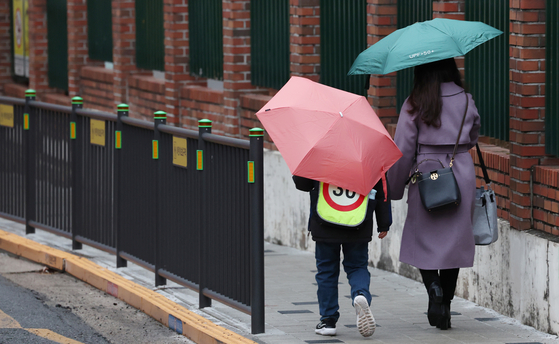An elementary school student and a parent walk to school in Seoul on February 5. [NEWS1]
The number of dual income households in Korea reached a record high last year, according to the state statistics agency, as the country maintains both strong employment numbers and the world’s lowest birthrate.
The figure rose 4.6 percent on year, or by 268,000, to 6.12 million last year, according to a report released by Statistics Korea on Tuesday, exceeding the 6 million-mark for the first time.
The number of single-person households increased at a lower rate of 2.3 percent during the same period.
The proportion of dual income families among married couples reached a fresh record of 48.2 percent, up 2.1 percentage points from a year earlier. The figure has been on a constant uptrend, recorded at 45 percent in 2020, 45.9 percent in 2021 and 46.1 percent in 2022.
The percentage of dual income couples increased in every age group. Notably, the figure was the highest for those in their 30s, numbering 58.9 percent, up 4.7 percentage points on year, marking the first time that the 30-somethings outpaced those in their 40s and 50s. The scale of on-year growth was also the steepest for the 30s demographic.
Couples in which both spouses worked comprised 57.9 percent of married pairs aged between 40 and 49 and 58 percent of those aged 50 to 59.
Households comprised of a married couple with children younger than 18 shrank by 26,000 to 4.1 million. Some 2.32 million of those households, or 56.8
Among them, 2.32 million households, or 56.8 percent, had both spouses working, a 3.5 percentage point increase from a year prior.
Working hours for households with underage children averaged 39.1 hours per week, up 2.1 hours from the previous year. The average stood at 42.6 hours for men, up 2.2 hours on year, and 35.5 hours for women, an increase of 1.9 hours.
The rising average age of marriage and the ever-plummeting birthrate, as well as last year’s significant job growth, are behind the growing number of dual income households, especially among those in their 30s.
The employed population increased by 327,000 to 28.42 million last year, continuing its upward turn that followed the Covid-19 pandemic. The employment rate of people aged 15-64 rose 0.7 percentage points on year to 69.2 percent, the highest figure since the statistics agency began compiling related data in 1989. The employment rate of women saw a 1.4 percent increase; the same figure remained flat for men.
The number of single-person households increased 164,000 last year to 7.39 million, up 2.3 percent on year. Some 63.3 percent of those individuals, or 4.68 million, were employed, an on-year increase of 0.2 percentage points. The average working hours for single-person households increased by 1.5 to reach 38.5 hours per week.
BY SHIN HA-NEE [[email protected]]

